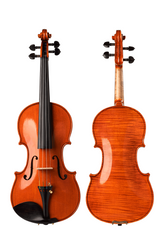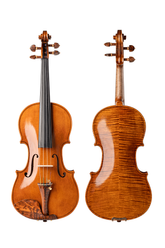As a violin beginner, have you really understood the violin bow?
The violin bow is an important part of playing the violin. Without a suitable violin bow, the unique performance of the violin cannot be exerted. As a violin beginner, you must fully understand the violin bow so that you can use it better. So what do you need to know about violin bows? Follow Fiddlover and easily know the bow in your hand.
Origin of the violin bow
As a stringed instrument, the violin and the bow have always been inseparable. A good violinist not only needs a high-quality violin but also a suitable violin bow to match, which is like a good horse with a good saddle. But good violins and good bows have not historically been made together. The recognized best luthiers of the violin are in Italy, and the best school of modern bow-making is in France.
The origin of the bow is generally believed to be in the 10th century AD, and the nomadic peoples in Central Asia were the first to use the bow. It then spread to China, North Africa, and Europe. Violin Bows In the early 18th century, the Italian Sonata type of bow was commonly used, which was considered the main bow of the Baroque period. During this period, Giuseppe Tartini (1692-1770) invented the octagonal structure of the bow, which together with the cylindrical structure make up the two structures of the present bow. In the mid-18th century, the development of the violin bow entered a transitional period. The German violinist Wilhelm Cramer (1745-1799) invented the bow named after himself. This type of bow has a wider hair width than the Italian Sonata type but is still narrow than today's bows. But this does not affect the bow making a big step towards the modern bow. Until the appearance of the French master of bow-making, Francois Tourte (1747-1835), he was known as the father of the modern bow. Started the production of modern bows. At that time Francois Tourte spent a lot of energy on the choice of wood when making bows, and eventually, he discovered Pernambuco wood from Brazil, which he thought was the most suitable for violin bows. To this day, violin bows made from this wood are also the best choice for high-end bows. In addition to the choice of wood, the selection of bow hair is also a top priority. In the end, he chose the French horsetail as his first choice. At the same time, the number of bow hairs also has a relatively standard number: about 150-200 (specifically how much The root needs to be selected by the master according to the characteristics of the horsetail hair material).
The structure of a modern bow
The structure of the modern violin bow is composed of Stick, Tip, Tip Plate, Hair, Thump Leather, Winding(or wrap), Eye, Ferrule, Frog, and Screw. A good bow is not only a perfect part of a certain part but requires the joint efforts of all parts to achieve a suitable state so that it can be called an excellent bow. Of course, for everyone or every violin, not a good bow is necessarily suitable for your violin, which needs to be judged according to the state of you and your violin. However, if you are a beginner, you don't need to worry about this, because generally beginner violin outfits will have bows that can match the violin, such as the Fiddlover Violin Shop's beginner violin series, and beginners You don't need to be very picky about the needs of the violin and bow, just enough to meet the practice. When you have a wealth of playing experience, you can upgrade your equipment.
A good bow is inseparable from good materials. For a bow, the most important part must be the selection of Stick and Hair materials.
Stick: At present, the market is mainly composed of three materials, wood, fiber-reinforced plastics, and carbon fiber. Among the three materials, the violin bow made of FRP is relatively cheap, and the quality is relatively poor. It is not recommended to buy it, but the price is relatively low, and it can also be considered if it is only used for practice. Violin bows made of wood and carbon fiber are relatively better, of course, it depends on what kind of wood or how the workmanship is. Among the wood materials, the wood materials that will be used are hematoxylin, Brazilian hematoxylin, green sandalwood, snakewood, Brazilian wood, mahogany, etc. The choice of wood materials has its considerations for bow masters in each country. It has the characteristics of good toughness, strong elasticity, and a good-looking appearance. However, in the market, Brazil wood and Pernambuco wood are more widely known. Carbon fiber bows are made of resin-bonded various carbon fiber materials. The bows made of this material are regarded as substitutes for Pernambuco bows (Pernambuco wood is currently a relatively scarce wood resource, and the bow made from it are also more expensive) and are more durable than traditional woods, making them suitable for beginners or violinists who often need to play outdoors.
Hair: Needless to say, horsetail hair is the most suitable material. In my opinion, horsetail hair is a gift from God to human beings, it is a purely natural material with the longest fiber in nature. Horsetail hair refers to the middle part of the horse's tail, not other positions. The structure of horsetail hair is hollow and scaly. It is characterized by good elasticity, strong resistance, and automatic filtration of water, and the strings have a good vibrate (due to the hairy scales on the horsetail).
The Working Principle of the Violin Bow
The bow is like an extension of the arm in the hands of the violinist, and it rubs with the bow through its bowing skills, to play a beautiful violin melody. Beginners of the violin must form a good habit of bowing with the help of the teacher in early learning, to avoid detours. Of course, be sure to apply rosin to the bow before use, and relax the strings after use. Use a soft cloth to wipe the rosin off the strings. Only by taking care of the bow can it be with you for a longer time. After all, a good sailor will surely wipe the deck of the ship carefully.
Finally, if you need to buy a violin bow, you can choose a violin bow from Fiddlover Violin Shop, you will not be disappointed. Follow Fiddlover to learn more about the violin.





